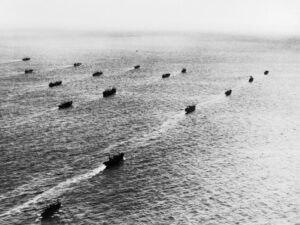Britain is an island and, during the war, almost all materials coming in or going out of Britain had to go by sea. The Germans knew this and used their U-boats, E-boats and aircraft to isolate Britain.
The first WW2 ship to be sunk by torpedo was Athenia, but the Germans denied responsibility, probably because they were afraid that the USA might join in the war. Mines were also used – contact mines which exploded if a ship hit them, and magnetic mines which were triggered by the steel hulls of ships. Many British navy ships used ‘degaussing’, current passing through copper strips to make them non-magnetic, and many ships were temporarily made safe by “wiping” their hulls with an electric coil. The Germans developed acoustic mines which were exploded by the ship’s engine noise. Minesweepers were used to remove the mines with, for acoustic mines, a jackhammer suspended in a box under its keel whose noise exploded the mines at a safe distance.
The first protected convoys were for the “Coalscuttle Brigade”, slow, small, coastal coal ships which were protected by armed trawlers. In 1940 many ships of convoy ‘Peewit’ were sunk by E-boats and German bombers, showing that U-boats were not the only threats to shipping.
The S.S. Automedon was captured by the Germans with, in its cargo, naval codebooks, so the Germans could read where all British convoys were headed. However, the British had managed to break the German ’Enigma’ code, which led to the sinking of the Bismarck. Breaking an ‘Enigma’ message would yield only a 100 square mile rectangle containing a U-boat, but new radar sets powered by a “cavity magnetron” whose magnets were developed by researchers at Sheffield University and made by Sheffield firms, enabled precise search inside that rectangle, while Asdic (sonar), in which a pulse amplifier sends out a soundwave under the sea and detects the echo from a U-boat, made the final pinpointing of the U-boat.
When America joined the war, it, did not at first use convoys protected by warships. Many tankers were sunk because they travelled in daylight, had all their lights burning at night, or were silhouetted against coastal illuminations. Britain sent ships and aircraft to protect American tankers.
Arctic Convoys first sailed in the Arctic winter during the long winter darkness, but later suffered heavily in the Arctic’s long summer days. In the Mediterranean in 1942 Malta was surrounded and running out of fuel so the ‘Pedestal’ convoy, including aircraft carriers was sent, but German and Italian aircraft, E-boats and U-boats sank one carrier, three cruisers and many freighters. The tanker ‘Ohio’, with a full load of fuel, was hit several times and split almost in two, but managed to reach Malta sandwiched between two destroyers. Ohio then discharged all her fuel before sinking!
Dr. Phil told us about many other convoys, including the Atlantic convoy ONS5 where centimetric radar, using the magnets developed by Sheffield University, helped destroy 13 U-boats which attacked the convoy. Those losses were unsustainable, and the Germans withdrew U-boats from the Atlantic.
D-Day saw the largest convoy, 7,000 vessels protected by 1,200 warships of the Royal Navy and other navies, to carry British and American and other nationalities’ troops to invade the French beaches.
There were about 1200 U-boats and 783 were sunk with others were damaged beyond repair. After the war only 4 were preserved intact.
Convoys were the important way the war was won but it was by a very narrow margin and at a huge cost in human life.

